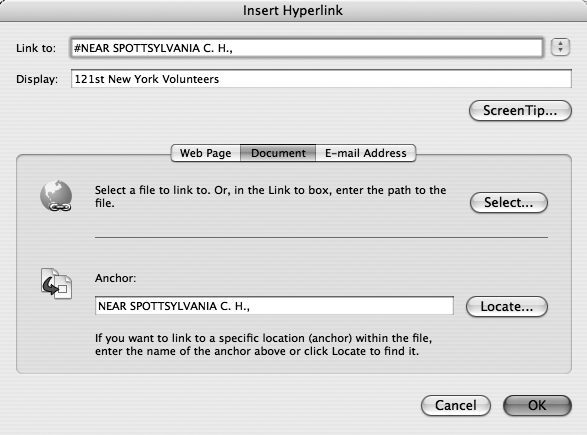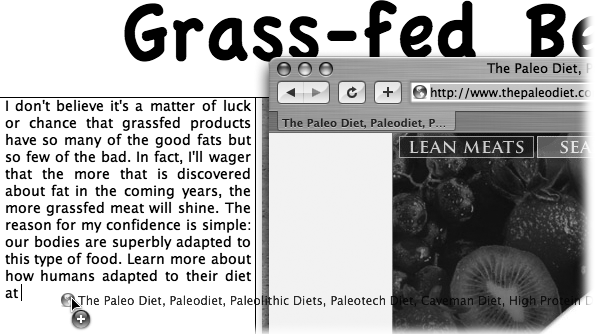Hyperlinks —buttons, graphics, or text phrases that, when clicked, take you to a different document—are what Web sites are all about. In Word, you can make just about any kind of link you’ve ever dreamed of—links to Web pages, to other documents or pages you’ve created, to movies or sound files, or to a point in the same document or another document.
Note
The Edit Hyperlink dialog box, which you’ll use in this section, has a Document tab that’s supposed to let you create a hyperlink to a document anywhere on your computer. But, as of this writing, it’s exceptionally flaky and doesn’t function at all using Tiger (10.4). In Leopard (10.5) it works, but opens a linked Word document in Draft view—which can be disconcerting since the page appears completely blank if it’s actually a Publishing Layout view document.
If your document is long, you may want links to help your reader navigate it. For instance, on a Web page (or even a senior thesis), you can place a link called “Back to top” at the bottom of your page, or a list of links at the top of the page that link to paragraphs farther down. Either way, this can save your reader lots of scrolling.
If you’ve used Word bookmarks (see Bookmarks) or its built-in heading styles in the target document, you can use them as anchors—the targets—for your links, like this:
Select the text (“Back to top,” for example) or graphic that will be the hyperlink; choose Insert → Hyperlink.
The Insert Hyperlink dialog box opens, as shown in Figure 9-8. The text you selected in your Web page document appears in the Display box. If a graphic will serve as the link, then <<Selection in Document>> appears in the box.
Tip
Microsoft doesn’t kid around about the Insert → Hyperlink command; it has about 731 alternate methods of triggering it. For example, you can also Control-click the selected text or object and choose Hyperlink from the shortcut menu, or click the Insert Hyperlink button on the Standard toolbar, or press ⌘-K.
Click the Document tab, then click Locate.
The “Select Place in Document” dialog box appears.
Choose the bookmark or heading, click OK, and then click OK.
If you haven’t successfully created any bookmarks or used one of Word’s built-in heading styles, Top of the Document is the only available choice. If you do have headings and bookmarks in the document, click the flippy triangles to view the entire list.
After you click OK to close the Insert Hyperlink dialog box, the text you selected in step 2 turns into a blue, underlined hyperlink. To test it, just click the link; the document scrolls so that the heading or bookmark anchor jumps to the top of the screen.
If you’re designing a Web site, of course, the link you’re probably most interested in creating jumps to another Web page. That’s why Word provides so many different ways of creating a hyperlink to another page on the Web.
As many an annoyed Mac fan can tell you, Word comes factory set to turn any Web address you type into a living hyperlink. Creating Web pages with Word is the one time you’ll actually be grateful for this behavior. Just type the Web address into your Web page document, beginning with www and ending with .com, .org, or dot-whatever. Word automatically creates the hyperlink (unless you’ve turned off this feature in Word’s Preferences, as described on Autoformatting as you type).
You don’t have to memorize and type a URL in order to place a hyperlink in your document. All you have to do is find it on the Web; then you can drag and drop the Web address into your Web page (although what appears on the page depends on the browser you’re using).
Open your Web browser and visit the Web page that you’d like to link to. Switch back to Word, and then drag the icon next to the Address window from the browser into your document, as shown in Figure 9-9. If you’re using Firefox, Word adds the Web address as plain text— not a hyperlink. Also, due to Word’s penchant for pasting formatted text, use the Paste Options button that appears next to your pasted address and choose Match Destination Formatting from the shortcut menu—or just copy the Web address and paste it into your document by choosing Edit → Paste Special and selecting Unformatted Text. Then, to make Word turn it into a hyperlink, place your insertion point immediately after the Web address and then press the Space bar. Finally—you’ve got yourself a hyperlink.
Figure 9-9. You can make a Web link in a Word document by dragging the address icon out of the address bar in Safari. These kinds of links aren’t only useful in Web pages, they’ll function in any Word document, launching your Web browser and taking you straight to that page.
If you’re using Safari or (for old times’ sake) Internet Explorer, Word creates a hyperlink field without any of the previous rigmarole. If you see the field code (see Fields) instead of the title of the Web page, select the entire field code and press Option-F9. In Safari, the field displays the actual Web address; in Internet Explorer, the hyperlink in your document will be the Web page’s title (as seen in the title bar of your browser window), not the URL itself. If you want to see the underlying URL, point to the Web-page name without clicking to make the identifying yellow screen tip appear.
If you’d like to use different text than the Web page’s real title or address for the hyperlink, edit the hyperlink as described on Selecting and Editing Hyperlinks. For example, if the Web page you’re linking to is titled “Actor Bio 2,” you might want to change it to the more descriptive “Brando: The Early Years.”
Note
Although there is an Anchor box on the Web Page tab in the Insert Hyperlink dialog box, the page has to have HTML anchor tags or Word bookmarks, as described on Bookmarks in order for this feature to work.
An email hyperlink, also known as a mailto link, opens a new, preaddressed message in your default email program (or the program of whoever clicks the link). When you create a Web page, it’s common practice to include an email hyperlink to yourself, so that your readers can contact you with questions, comments, or orders. To do so, just follow these steps:
Type and select the text (“Contact me”) that will become the email hyperlink.
As with any other hyperlink, you can use a graphic, but you should also include some text to make it clear what the link does.
Choose Insert→ Hyperlink. In the Hyperlink dialog box, click the Email Address tab. In the To box, type the email address you want the link to mail to.
The Recent Addresses list contains a list of email addresses for which you’ve recently created hyperlinks (not necessarily ones you’ve actually used). To look up an address in your Entourage Address Book instead, click Launch Email Application. No matter what your default email program, Entourage launches. There’s no further integration with Entourage, however, so you’ll have to manually copy and paste the address you want out of its Address Book.
Press Tab; type a subject line, if you wish.
In other words, when your visitor clicks the “Contact me” link, his email program will automatically open. When it does, an outgoing blank email message will appear, preaddressed to you and with the Subject line already filled in. Including a subject line can help you keep track of emails that come from this particular Web page. However, not all Web browsers, or all email programs, work with the subject-line-in-an-email-hyperlink feature.
Click OK.
The email link is ready to click.
Note
If all you need is a simple Web or email hyperlink, just type it into Word. Word creates the hyperlink instantly (if, that is, you haven’t turned off this feature in the Tools → AutoCorrect → AutoFormat As You Type dialog box). Later, should you want to change the link to read “Contact Me” or something more elegant-looking than your plain old email address, edit the link as described next.
Likewise, for simple addresses like www.apple.com, just type the URL into your document. You can always go back and change the text later, as described next.
When you click a hyperlink in Word, Word follows the link, even if that means launching your Web browser. But if clicking triggers the link, how are you supposed to edit the hyperlink text?
The easiest way is to Control-click (or right-click) the link and choose Hyperlink → Edit Hyperlink from the shortcut menu. The Edit Hyperlink dialog box opens; here you can change the URL, email address, display text, screen tip (see the box below), anchor, and so on.
If the dog ate your Control key, you can also highlight the link by carefully dragging across it or moving the insertion point into it with the arrow keys, then pressing ⌘-K (or choosing Insert → Hyperlink) to open the Insert Hyperlink dialog box. In fact, if all you want to edit is the display text for a hyperlink, just drag carefully across it (or Control-click it and choose Hyperlink → Select Hyperlink) and then retype.
Similarly, you can edit graphic links without triggering them; once again, the trick is to select the link without activating it—by Control-clicking it. After editing the image using the Formatting Palette or the Drawing or Picture toolbars, press Esc or click elsewhere to deselect the object and avoid inadvertently making further changes.
In Word, text hyperlinks appear in blue type until they’re clicked, whereupon they change to purple. You can change these colors, if you like; the trick is to change the Hyperlink style, just as you’d change any Word style (see Changing, Deleting, or Copying Styles for instructions).
If you can’t stand to work with colors that aren’t your own, you can even change the color that clicked hyperlinks change into after being clicked. Just modify Word’s built-in Followed Hyperlink style.
These new hyperlink colors override default hyperlink colors when the page is opened in your Web browser. If your colors don’t work, it’s because your visitor has changed his browser preferences to override the color choices that have been programmed into Web pages.
To remove a hyperlink you no longer want, you have two options:
Drag over the hyperlink text and press Delete or position your insertion point after the link and press the delete key until you’ve expunged it. Both the hyperlink and the display text or object are deleted.
To cancel out the link while leaving the display text or object in place, Control-click the link and choose Hyperlink → Edit Hyperlink on the shortcut menu. Click Remove Link.


